What to Know About Colored Contacts—and Why You Shouldn’t Buy Over-the-Counter Brands
"Hearst Magazines and Yahoo may earn commission or revenue on some items through these links."
Bored of your eye color and want to change it up for a day? Colored contacts give you that power for a subtle, removable makeover that takes literally seconds to apply. The catch is knowing how to safely get the right pair for this beauty trick that isn’t as mainstream in the U.S. as it is in Asia.
For years, colored contacts have made headline-generating appearances on celebrities like Selena Gomez and Kylie Jenner. More recently, Blackpink’s Jisoo wore them to Dior’s Paris Fashion Week show in late September.


K-pop idols, in fact, regularly change their eye color with lenses for visuals and music videos. Girl group NewJeans even partnered with major Korean colored contact brand Olens to model their offerings.
The choices are more plentiful than ever, with online brands like Olens, PinkyParadise, and Solotica offering a dizzying array of colors and low prices on their contacts, which customers can buy without a prescription. But there is a good reason to avoid these over-the-counter retailers: Contacts that aren’t prescribed by an eye doctor can do severe and devastating damage to your eyes. (It additionally isn’t legal to sell contacts in the U.S. without a prescription.)
The reason is two-fold, Dr. Rupa Wong, MD, spokesperson for the American Academy of Ophthalmology and pediatric ophthalmologist at Honolulu Eye Clinic, told ELLE.com. Contact material and fit matter a lot.
“We have contact lenses that are quote ‘FDA approved’ from the 1970s all the way to present times, but each generation of contact lenses gets healthier and better for your eyes,” she explained. “Now all contact lenses require a prescription, even cosmetic circle contact lenses, anything, cosplay, Halloween ones. And the reason for that is a contact lens has a particular shape, and it must be fit to the surface of your eyes. So there’s not a one size fits all.”
“When you go to your eye doctor, they’re actually measuring the curvature of the front surface of your eye and then determining which brand of contact lenses, which size of contact lenses fits your eye,” she continued. “So that’s why it’s important even if it’s a cosmetic contact lens that you have a prescription, because if you are wearing a contact lens that’s not fit properly to the surface of your eye, it can cause a lot of complications.”
Dr. Wong and Dr. Brieann Adair, O.D., of NYU Langone Eye Center both stressed that contact lenses are medical devices.
“The eye tissue in the front of the eye is living, breathing tissue that needs oxygen at certain levels,” Dr. Adair told ELLE.com. “We need water content at certain levels, movement of tears. And what we’re seeing with a lot of these over-the-counter contact lens products that you see at beauty supply stores or online [is that] there’s really no regulation of the sterility of those products or how they’re being created, how they’re being formed, how they’re being packaged, how they’re being stored once they’ve come out to you. So you really don’t know what you’re getting.”
So, how do you safely get colored contacts—and what can happen when you use over-the-counter pairs? Dr. Adair and Dr. Wong explain what you need to know about colored contacts.
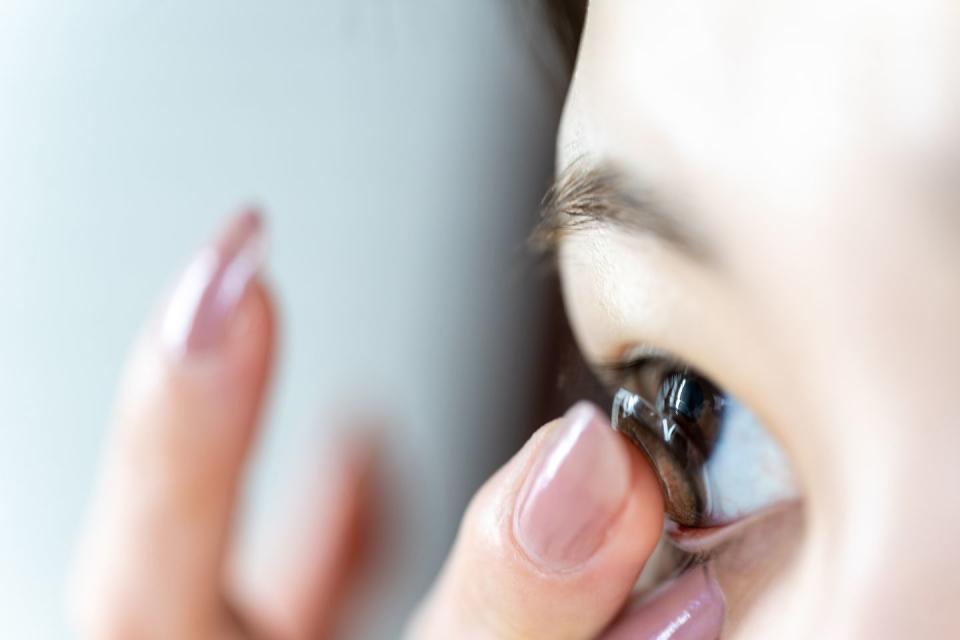
The risk of wearing over-the-counter contacts, explained
You may have friends who have used over-the-counter brands with no issue or think you’ll only be wearing them for a couple of hours, so how much harm can they cause? But complications from wearing those lenses even temporarily can range from mild eye irritation to corneal ulcers and permanent vision reduction, Dr. Adair and Dr. Wong said.
“Best case scenario, the lens might be a little bit uncomfortable. It can cause dryness or irritation on the front surface of the eyes,” Dr. Adair began. “Some people can have allergic reactions to the actual lens material. And those are things, luckily, that will resolve within a day or two after you stop wearing the lens. A lens that’s tight on the eye, though, can cause the eye to swell. If it’s too tight, the eye’s not getting enough oxygen, the front of your eye can actually swell.” That can cause blurry vision, pain, and inflammation in the eye that may require medical treatment.
Corneal ulcers, meanwhile, are “very common” bacteria infections on the front surface of the eye, Dr. Adair said. They can lead to similar side effects and something far worse: scarring on the eye, which can permanently reduce vision.
If your eye is bothering you, do not ignore it or assume it will just go away: If left on its own, “the inflammation can spread just from the front surface of the eye to start to penetrate a little bit deeper so people can get into some really scary situations,” Dr. Adair said.
Corneal ulcers left untreated can lead to needing a corneal transplant, Dr. Wong said.
She noted that “most of the time you don’t have a severe infection or go blind or require a corneal transplant, but when it does happen, it’s terrible.” It’s also easily avoidable by just getting a colored contact prescription through your doctor.
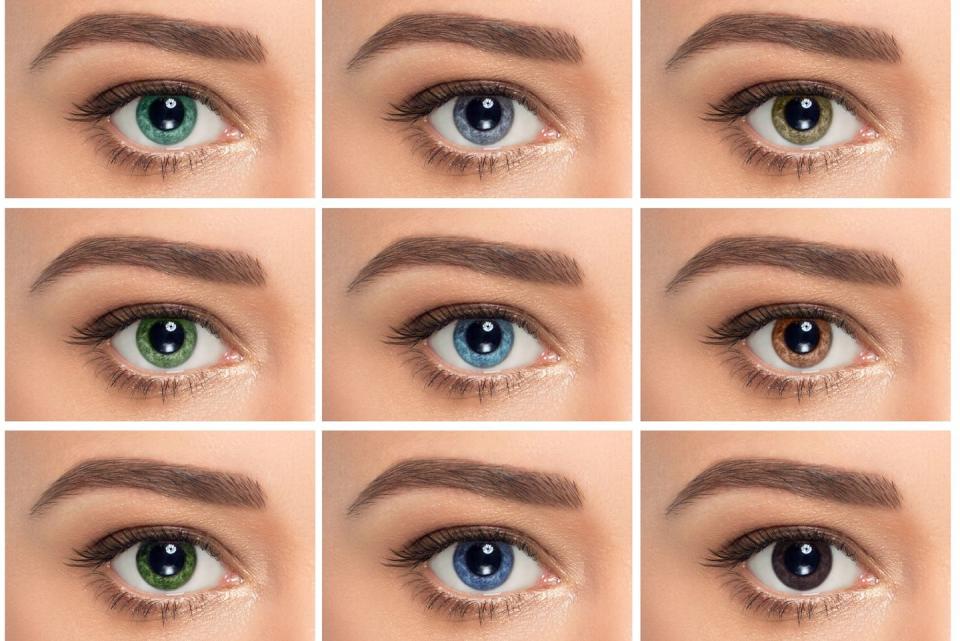
What is in safe, prescription colored contacts?
U.S. brands have come a long way in making more comfortable, safe colored lenses.
Contacts basically come in two materials: hydrogel and silicone hydrogel, Dr. Adair said: “We are now seeing that these better, high quality materials move better on the eye. They allow more oxygen to the front of the eye; they have wetting agents that keep them moist [and] comfortable. And they have UV protection [and] blue light protection. And that’s pretty much standard in a lot of the newer lenses that are on the market.”
Colors may be a little less vibrant on prescription U.S. brands than online brands, but that is for safety reasons, Dr. Wong detailed: “The FDA-approved lenses in this country, they don’t have as much pigment because we want the eyes to be healthy and safe at the end of the day.”
Too much pigment on the lens makes it less oxygen permeable and more risky to wear. “The peaks in the pigments really retard the progression of the oxygen, and they make the lens a lot thicker and less breathable,” Wong said. “So your eye likes oxygen, and when it doesn’t get oxygen, that’s also a setup for getting these kinds of infections.”
How has the colored contact lens market changed in the last couple of years?
Trend-wise, “it’s an interesting time in the market,” Dr. Adair said, pointing out lenses that enhance the limbal ring, the outer edge of your eye, are becoming more popular due to K-pop stars. Those contacts “can make the white of your eye look more white, your eyes look bigger, more open.”
Quality has greatly improved for those who need vision correction, too. “There’s better lens options now,” she added. “So people with higher prescriptions used to have more limited options, but a lot of the brands have widened the availability, how high a prescription you can get in a colored lens. So it’s an option for people with zero or very small prescription. But a lot of them go all the way up to say minus 8, 9, 10 nowadays.” At this point though, there are no astigmatism correcting lenses and no multifocal style lenses in colored styles.

How to find natural-looking colored contacts
Some contacts blend with your natural eye color (better for people with light eyes), while others mask it more (better for people with dark eyes).
Dr. Wong said that Acuvue Define, Air Optix Colors, and Dailies Colors are the top three U.S. prescription brands.
Acuvue 1-Day Define are daily contact lenses. They are subtle and enhance natural eye color. They are good for one-day wear and won’t work well on dark eyes.
Air Optix Colors are monthly contact lenses with 12 color options, from hazel to amethyst. They mask natural eye color more but still blend a bit with it, so lighter colors do work on darker eyes. They also have more pigment than daily lenses, so Dr. Wong recommends them for a greater color transformation.
Dailies Colors are the daily version of Air Optix’s colored contacts line. They have four color options: gray, hazel, blue, and green.
To find a lens that looks more natural, look at where the color is on the contact: “Some of the contact lenses, all the pigment is on the front surface so it gives this very artificial look to the contact lens,” Dr. Wong said. “Other contact lenses have pigments through the entire lens, so it creates a little bit more depth and makes it look a little bit more natural when wearing the contact lens. Also, the size of the opening for the pupil versus your own opening, that also can make things look either more artificial or more realistic.”
It is worth trying the lenses on too, Dr. Adair said, to see which works best with your natural eye color. Air Optix Colors, for example, has three shades of blue that can appear really different on people: “It seems very subtle, the differences in shades really do make a big impactful difference.”
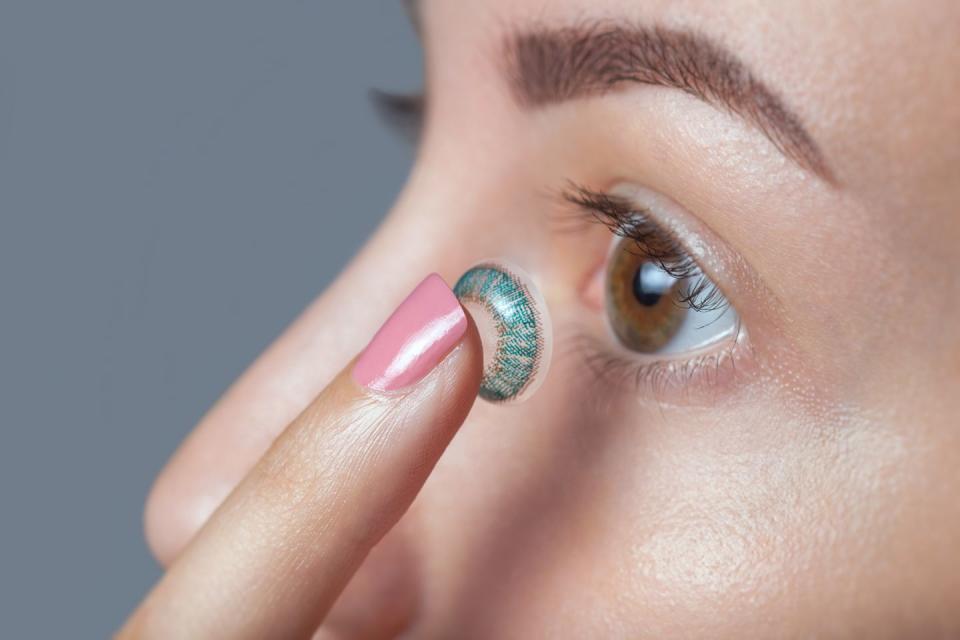
How to get Halloween and cosplay lenses
Your eye doctor can order special lenses for you for Halloween and cosplay, which are also prescription lenses from reputable manufacturers like ClearLab. Your eye doctor will “make sure that it fits, that it passes all the safety protocols, and you can still get a really good look. But we caution the patients in terms of how long they wear them,” Dr. Wong said, as those lenses often have more pigment on them.
How long does it take to get colored contacts?
The process can be really fast. “If you have five days at least [until you need them], you definitely can do this,” Dr. Adair said. “When you go in for an assessment, they’re going to put a lens on the eye that day to check the fit, to check the curvature, check your comfort and any prescription power you may have.”
From there, you’ll receive a prescription and can order the lens in whatever color you want. “Just like anything nowadays, next day shipping, you can get those lenses in and then you can have them checked again if needed to make sure that the fit is appropriate,” she said.
Can you get custom colored contacts?
Yes, you can. “I know that sounds really cost prohibitive, but it really is not,” Dr. Adair said. “It does require a couple extra visits. But I, for example, fit those in my office. Those are ones that can have a tint of a color on it, so it can be a lot more subtle and natural and blend with your natural eye color. Most optometrists or ophthalmologists who fit contact lenses would be able to build that type of contact lens for you. And from a price perspective, they’re actually priced very similarly to the over-the-counter generic contact lens.”
What to expect when getting fitted for colored contacts
Get ready to play dress up with your eyes. Your eye doctor will provide trial pairs in multiple colors for you to try so you can choose the right shade. (If you have never used contacts before, they will also teach you how to insert them.)
The lenses will not have a prescription in them, so be sure to bring glasses if needed to see yourself more clearly. The prescription your doctor writes for you will include the colors you pick so you can order the lenses online or through your eye doctor.
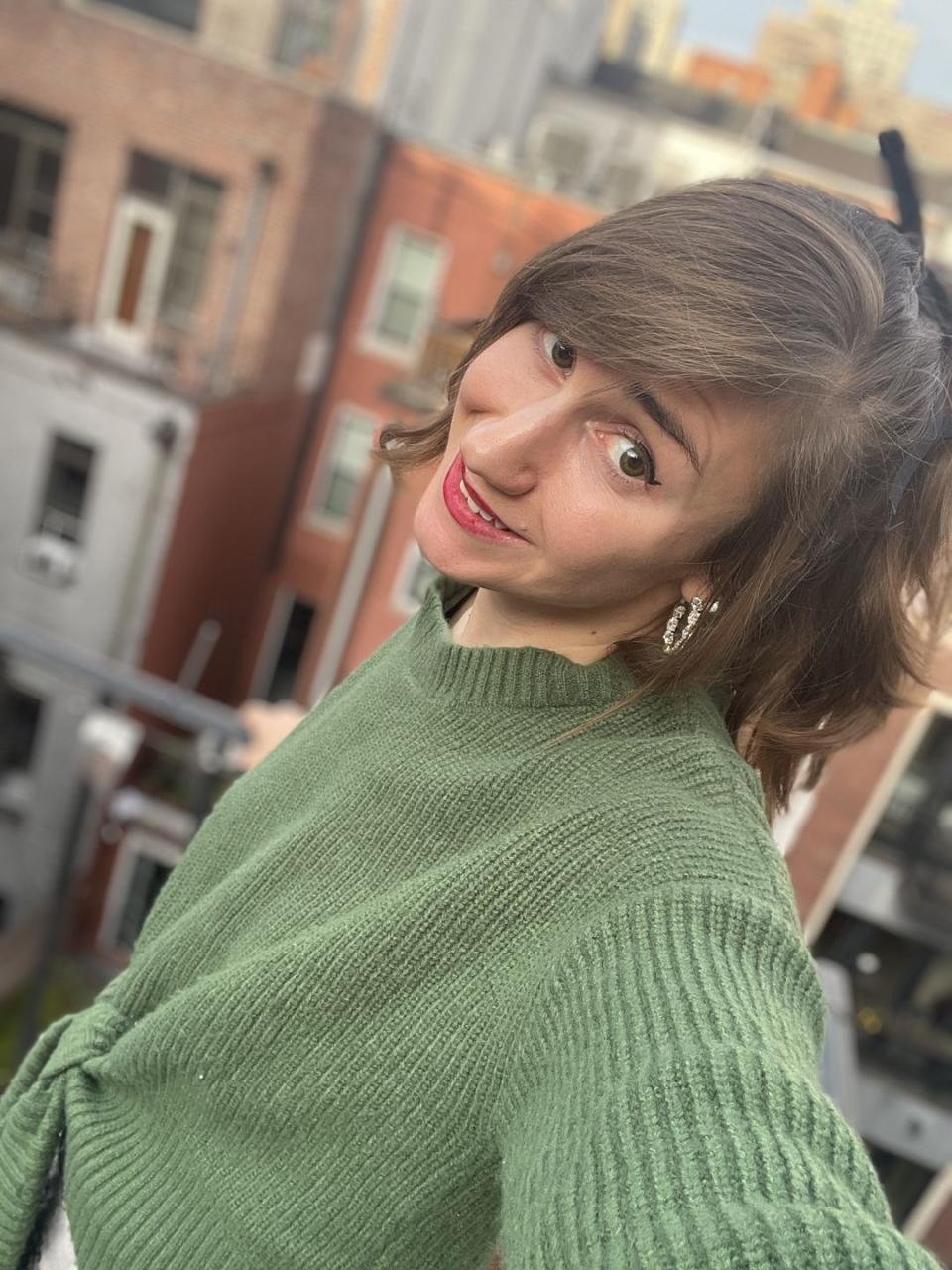
I tried Air Optix Colors and have dark brown eyes. It is critical to try the colors yourself, especially with that brand where the lens color blends a bit with your natural eye color.
They do change brown eyes well though, as long as you pick the right shade. For example, I was surprised that while Air Optix’s regular blue lens worked on my brown eyes, their green did not.
They have more dramatic options for both colors, Gemstone Green and Brilliant Blue. Brilliant Blue looked striking on my eyes—a good Halloween look but not everyday. But Gemstone Green worked the way I thought the standard green would: It transformed my brown eyes into a natural, pretty green. Paired with my light brown hair, it was my favorite color I tried.
One box, which contains six lenses, will last three months if both eyes have the same prescription. It cost $105 through my eye doctor. On 1-800-Contacts, Air Optix Colors are priced at $115 for a box of six lenses.
In terms of comfort, Air Optix Colors are very close to how my regular lens (Acuvue Oasys) feel. They are fine to wear throughout the day. Could I see any of the pigment on my eye? Not really: On the green pair I tried, the view was identical to my usual contacts. I forgot I had colored contacts in most of the time I wore them.
Contact care really matters here, so be sure to clean your hands before removing the lenses, store them in a contact case with fresh solution, and do not sleep in them. I personally love Biotrue’s contact solution to keep my lenses feeling clean.
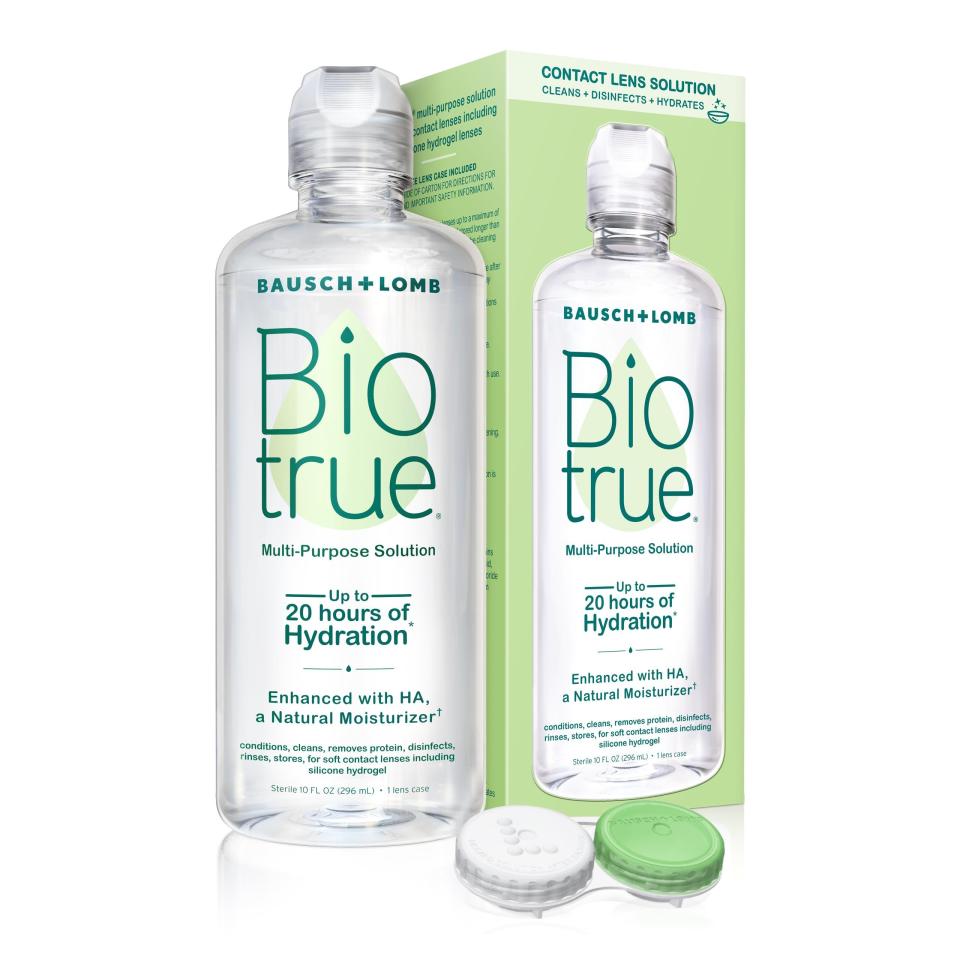
Contact Lens Solution by Biotrue, Multi-Purpose Solution for Soft Contact Lenses, 10 Fl Oz (Packaging may vary)
amazon.com
$8.88
I have to admit, I felt a little self-conscious when I first wore the lenses because I had tried a much more vibrant blue as a teenager. But this time, the color was a better fit for me, and my friends who saw me in the lenses were impressed with how subtle and natural the color looked. My male friends didn’t notice until I pointed it out (this is not terribly surprising; many of them don’t pay attention to eye color), while my female friends asked if I was wearing colored contacts fast.
One friend even suggested I wear them on dates because they make my eyes more striking. I haven’t yet, but I’m not against it. Overall, if you want to wear them, you absolutely should with confidence.
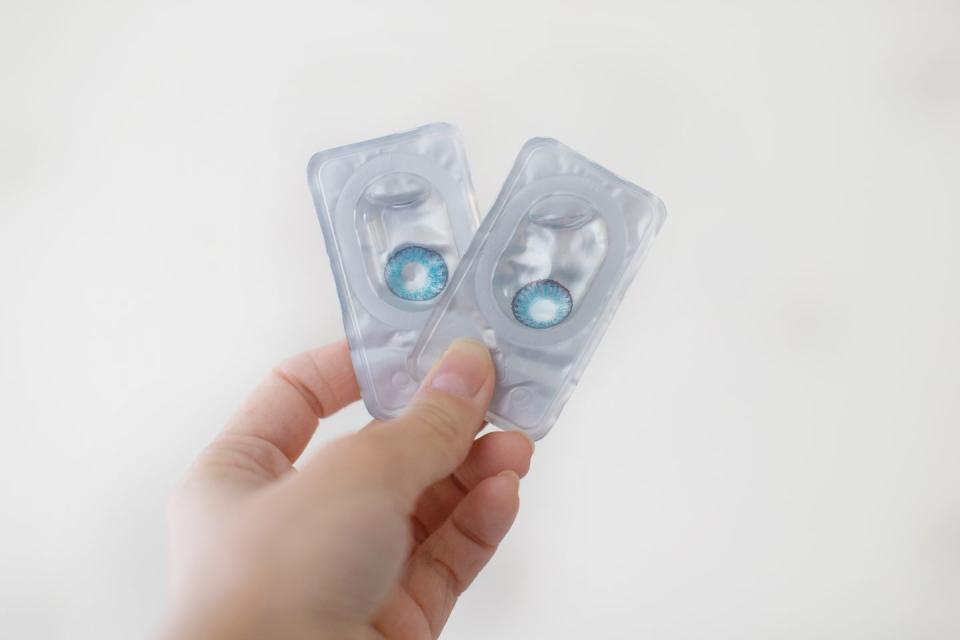
Are monthly, daily, or bi-weekly colored contacts best?
It depends on how much you plan to use them and how much you want to spend.
“The monthly replacement lenses, the 30-day lenses are always going to be more cost-effective because you’re getting less lenses,” Dr. Adair said. “If you look at some of the two week or daily options, the daily is always going to be more expensive because just the quantity of lenses is higher. So that is something to think about. But they’re very close in price.”
While having dailies is best for your eyes because the new lenses each day minimizes your chance of eye infection, longer-lasting lenses are perfectly safe, too, as long as they are stored correctly.
“With a two-week or a monthly lens, you have to remember to be changing out the solution, to not top off where you just add more solution to your case,” Dr. Wong said. “All of those are different steps that need to be done with two-week and monthly lenses, which can sometimes, if improperly done or not done at all, can cause an infection.” Monthly lenses can be worn for 30 days from the day you open them, while bi-weekly lenses are good for two weeks.
Other rules? Do not sleep in your lenses ever or share them. Wash your hands before inserting or removing them, and do not put tap water on them because it can cause the lenses to change shape, swell, and stick to the eyes, leaving you at greater risk for an infection, per the CDC. And listen to your eyes: “If you have any pain, irritation, things like that, lens comes off of the eye, you go in to see your doc,” Dr. Adair said.
You Might Also Like

